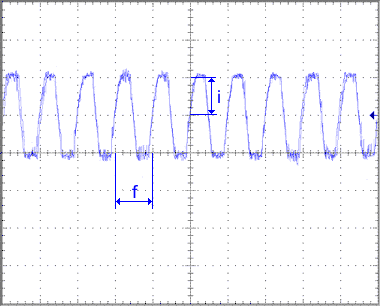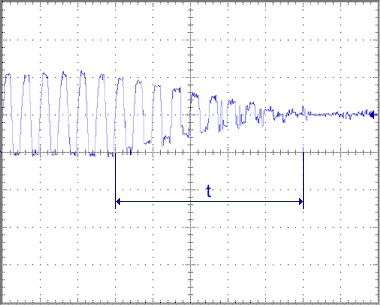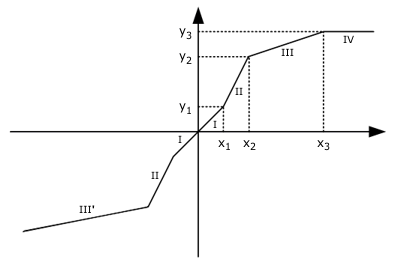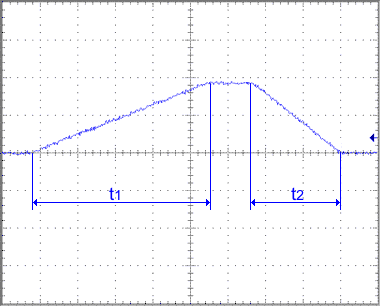Functions
The KL2535 and KL2545 pulse-width current terminals include an integrated PWM output stage (up to 175 W) in a very compact design.
General functions
Enable/Readiness for operation
The enable bit CB1.5 in the control byte must be set in order to activate the output stage. If the terminal is not subject to an error at this time, it acknowledges the command by setting the ready bit, SB1.4, in the status byte
Setting/deleting the position (KL2545 only)
The current position value of the encoder can be set or deleted by the user. Register R1 is the reference for this. A rising edge at bit CB1.1 sets the current position, and the acknowledgement is provided through status bit SB1.1.
Latch functions
The internal encoder offers the option of registering a latch event. A latch event can be generated via the digital input signals.
The terminal response to the latch events is activated as follows:
- Setting the control bit CB1.2 activates the rising edge at the digital input (highest priority)
- Setting the control bit CB1.3 activates the falling edge at the digital input (second-highest priority)
Once the user has enabled the function, during the next latch event, the terminal saves the current position value and indicates this by setting status bit SB1.2. Reading out the latch value must be started by setting CB1.4; this will map the latch value into the DataIN process data (the terminal indicates this through status bit SB1.3).
 | Enable for latch values The enable that was set previously must be retained while reading out the latch value. The latch values are lost if the enable is removed! |
Error indication
The terminal offers the user a variety of diagnostic options. These messages are divided into hardware warnings and hardware errors.
Hardware warnings
When one of the following warning occurs, bit SB1.5 (Warning) is set in the status byte.
Hardware error
If one of the following errors occurs, the load is de-energized and bit SB1.6 (Error) is set in the Status byte.
- UnderVoltage R0.11
- OverCurrent, R0.12
- Open load / broken wire (OpenLoad, R0.13)
- Failure of the 24 V control supply (NoControlPower, R0.14)
(The terminal is automatically reinitialized when the control voltage returns)
If an error occurs, it first has to be rectified and subsequently acknowledged and thus cancelled by setting bit CB1.6 in the control byte.
Dithering
Feature bit R32.5 and control bit CB1.0 must be set to activate the dither.
The purpose of this function is to eliminate magnetization effects. Dithering involves modulating a rectangular signal on top of the actual output value. The configuration required for this depends a lot on the particular application. It must be determined with the aid of the characteristic data of whatever actuator is connected.
The following parameters can be set:
|
Name |
Register |
Value range |
Description |
|---|---|---|---|
|
Frequency - f |
10 Hz to 500 Hz |
The frequency of the rectangular signal; the resolution of the setting is 1 Hz. | |
|
Amplitude - i |
0% to 100% |
The amplitude of the rectangular signal; the resolution is 1% (with reference to the output current that has been set in register R36) | |
|
Switch-off ramp - t |
0 ms to 32767 ms |
When switched on, the dither signal jumps immediately to the amplitude set in R38. When switched off, the signal is attenuated linearly over the time configured here; the resolution is 1 ms. |


Valve curve
Feature bit R32.4 must be set in order to activate the valve curve.
The following parameters can be set:
|
Name |
Register |
Value range |
Description |
|---|---|---|---|
|
Overlap threshold value - x1 |
0 to 1000 |
The overlap range ends at this process data value; the resolution is 0.1% (as a fraction of 32767) | |
|
Overlap output value - y1 |
0 to 1000 |
The maximum output current in the overlap region; the resolution is 0.1% (with reference to the output current that has been set in register R36) | |
|
Bend compensation -threshold value- x2 |
0 to 1000 |
The bend compensation range ends at this process data value; the resolution is 0.1% (as a fraction of 32767) | |
|
Bend compensation - output value - y2 |
0 to 1000 |
The maximum output current in the bend compensation region; the resolution is 0.1% (with reference to the output current that has been set in register R36) | |
|
Area compensation - threshold value - x3 |
0 to 1000 |
The area compensation region ends at this process data value; the resolution is 0.1% (as a fraction of 32767) |
The characteristic curve is divided into four regions:
|
I |
Overlapping |
|
II |
Bend compensation |
|
III, III' |
Area compensation |
|
IV |
End region |

Process data ramps
Feature bit R32.6 must be set in order to activate the process data ramps.
This function offers the facility for automatically changing the output current from the current process data value to the new one up or down along a linear ramp. The values of registers R45 and R46 here are related to the entire process data range, i.e. from 0 to 32767.
The following parameters can be set:
|
Name |
Register |
Value range |
Description |
|---|---|---|---|
|
Rising ramp - t1 |
0 to 32767 ms |
The time, t1, required for the process data value to rise from 0 to 32767 (resolution: 1 ms). | |
|
Falling ramp - t2 |
0 to 32767 ms |
The time, t2, required for the process data value to fall from 32767 to 0 (resolution: 1ms). |
